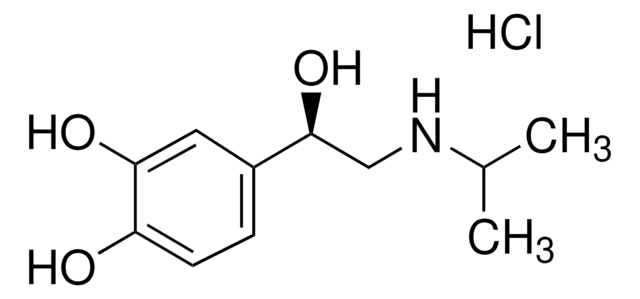I5627
Isoprenaline hydrochloride
≥98.5% (TLC), powder, β-adrenoceptor agonist
Sinónimos:
(±)-Isoproterenol hydrochloride, 1-(3′,4′-Dihydroxyphenyl)-2-isopropylaminoethanol hydrochloride, N-Isopropyl-DL-noradrenaline hydrochloride
About This Item
Productos recomendados
Nombre del producto
Isoprenaline hydrochloride,
Nivel de calidad
mp
165-175 °C (dec.) (lit.)
emisor
Sanofi Aventis
cadena SMILES
Cl.CC(C)NCC(O)c1ccc(O)c(O)c1
InChI
1S/C11H17NO3.ClH/c1-7(2)12-6-11(15)8-3-4-9(13)10(14)5-8;/h3-5,7,11-15H,6H2,1-2H3;1H
Clave InChI
IROWCYIEJAOFOW-UHFFFAOYSA-N
Información sobre el gen
human ... ADRB1(153) , ADRB2(154) , ADRB3(155)
¿Está buscando productos similares? Visita Guía de comparación de productos
Acciones bioquímicas o fisiológicas
Características y beneficios
Otras notas
Código de clase de almacenamiento
11 - Combustible Solids
Clase de riesgo para el agua (WGK)
WGK 2
Punto de inflamabilidad (°F)
Not applicable
Punto de inflamabilidad (°C)
Not applicable
Equipo de protección personal
dust mask type N95 (US), Eyeshields, Gloves
Elija entre una de las versiones más recientes:
Certificados de análisis (COA)
¿No ve la versión correcta?
Si necesita una versión concreta, puede buscar un certificado específico por el número de lote.
¿Ya tiene este producto?
Encuentre la documentación para los productos que ha comprado recientemente en la Biblioteca de documentos.
Los clientes también vieron
Nuestro equipo de científicos tiene experiencia en todas las áreas de investigación: Ciencias de la vida, Ciencia de los materiales, Síntesis química, Cromatografía, Analítica y muchas otras.
Póngase en contacto con el Servicio técnico











